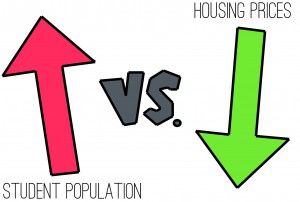The benefits of attending a small university are manifold: Pepperdine has long enjoyed a reputation for offering its students intimate class sizes, the chance to build meaningful relationships with professors and on-campus living spaces that have been lauded for both livability and luxury.
Bigger is not always better, and quality has traditionally been prioritized over quantity on the Seaver campus, until now. We reported last semester on the university’s new vision for an expanded Seaver College, which includes new incentives (and new regulations) that are aimed at increasing the number of students living on the Malibu campus.
Incoming students are required to live in Pepperdine housing for four semesters, either on the Malibu campus or abroad. The school is offering a discount for students who elect to cram themselves into triple rooms—which are actually the same dorms students are already familiar with, only with three people living in them, rather than two.
Students who live in on-campus housing for six semesters will receive a 10 percent discount, and those who live on campus for a full eight semesters will get 20 percent off. Ocean views are another amenity that the school offers as an incentive.
Realistically, these discounts will save students roughly $11,000 over their four-year careers at Seaver—and that’s if these new entrants to the Seaver campus select the most inexpensive cost options. This is all part of a larger program of expanding the Seaver campus, not so much to alleviate the demand of the current student body, but in anticipation of an increasing student population.
These cash incentives fail to account for the true costs of living in closer quarters (including, but not limited to, the reduction of closet space from these tripled-up rooms).
Living with a roommate can be difficult enough when only two people are involved. It is hard to get used to each other’s habits, schedules and quirks, and learning to live harmoniously with a stranger in close quarters while juggling sleep and study time is difficult even when you and your new roommate complement each other well and get along with little personal drama (which isn’t always the case).
For those underclassmen who are electing to triple up, these issues are multiplied threefold. Certainly the stress of being a first-year college student is enough of a burden without sharing a bedroom with two other people and fighting over nonexistent closet space?
It’s still too early to determine if these triples will have detrimental effects on the students who live in this experimental new housing option, but the effects that a chaotic living space and lack of sleep can have on new, inexperienced students can be catastrophic. Students’ grades shouldn’t have to suffer because they choose to save money on campus housing.
New transfer students should also be wary of Seaver’s new housing policies: they are required to live on campus for at least one semester. This new requirement by the school doesn’t explicitly account for those new transfer students who already live in or around Malibu.
When paired with the largest freshman class in this school’s history, things are beginning to feel a little bit cramped in Malibu.
The fall semester has just begun, and signs of Seaver’s recently accelerated growth are already apparent. Not all of these signs are positive:
Parking on campus has never been more difficult, even accounting for the mad crush that’s customary with the start of a new semester. As freshman classes continue to grow, this issue will only continue to worsen unless the school addresses it.
Living space and parking aside, class sizes will grow and waitlists will get longer due to Seaver’s expansion. Even with the school’s addition of 27 new teachers to the Seaver faculty to alleviate the increased demand, the Seaver campus may soon have to face an issue that has plagued universities across the country since the start of the recession: overcrowding in the classroom.
If Seaver’s student body continues to increase, the problem of overcrowding will only become more urgent, threatening the intimate class sizes and one-on-one relationship between teacher and student that Pepperdine has always boasted.
Individually, the changes taking place in Malibu are good for the students and the image of the campus—Seaver College should strive to make its housing more competitive with the off-campus housing market, but it cannot do that at the expense of students’ quality of life.
If Seaver must grow, it should do so gradually. Discounts and ocean views do not address the deeper issues of an institution going through a growth spurt in a poor economic climate.


